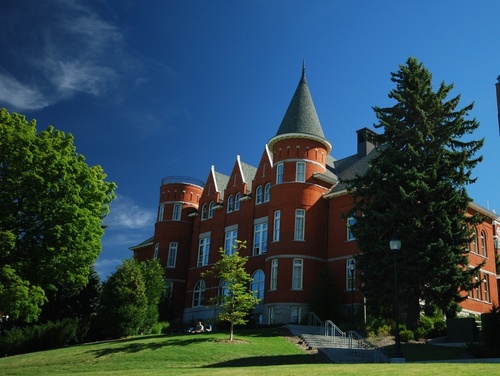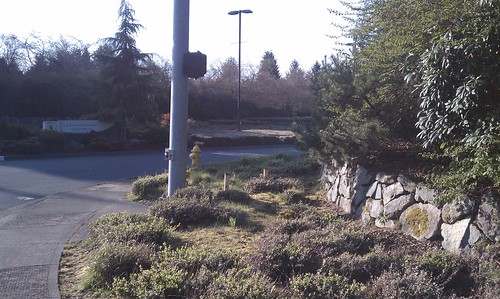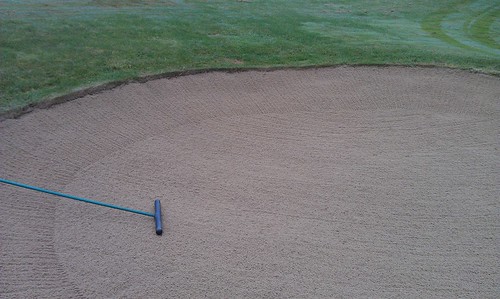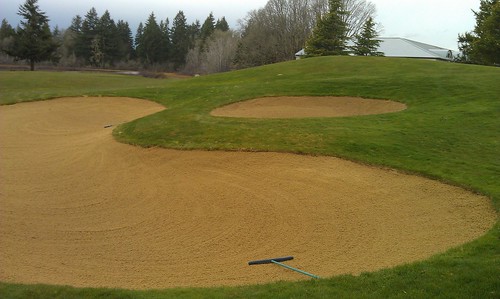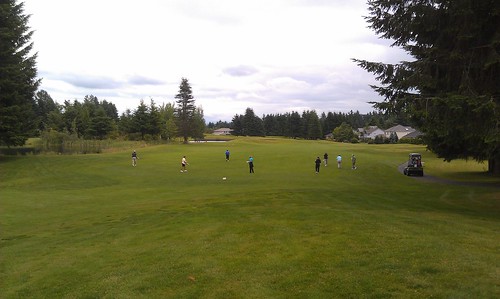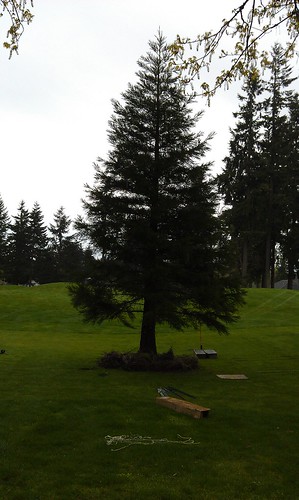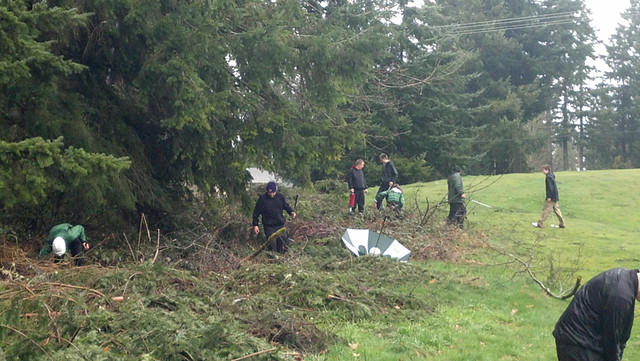The chipping green at the practice facility was not a good representation of the golf course this last year. We decided to make use of our aerification plugs from the greens to renovate the small chipping green.
We redesigned the chipping green to have three separate tiers and nearly double the square footage. The reason for the larger size was to give us the ability to use a portion for a nursery if we needed. We also wanted to make it possible to practice a variety of different shots around the green.
The green is coming along really well and we are planning our first cut very soon. If you have any comments or questions about the renovated chipping green, please contact me.
Justin Ruiz, CGCS, MG
justinr@indiansummergolf.com
Practice Area Upgrade
Posted by
Unknown
If you have been to the practice area lately, you have probably noticed the chipping green has been renovated. For quite some time the chipping green has been lackluster to say the least. The green was not a good representation of the golf course.
A few weeks ago we stripped the old sod off of the chipping green and re-graded the sand underneath. We enlarged the green in hopes to make use of some of the area on the course if needed. We are also trying to create more of a variety of chip and pitch shots to practice.
This season we also tried to make the driving range a little more interesting with better targets. We mowed out several areas that were most likely previously used for target greens. We also added some flags at short intervals to hone in your wedges. I think this has worked since the amount of debris left on the range tee has increased quite a bit since we mowed out these areas.
Stay tuned for more improvements over the winter and next spring. We have a laundry list of things to do. Don't forget to talk up the club to your friends. It is a pretty exciting time to join the club.
Also, don't forget to fill out your survey. The survey is important to help get your opinion heard on what you like about the club and what we can do to make your membership more valuable.
If you have any question please contact me.
Justin Ruiz, CGCS, MG
justinr@indiansummergolf.com
A few weeks ago we stripped the old sod off of the chipping green and re-graded the sand underneath. We enlarged the green in hopes to make use of some of the area on the course if needed. We are also trying to create more of a variety of chip and pitch shots to practice.
This season we also tried to make the driving range a little more interesting with better targets. We mowed out several areas that were most likely previously used for target greens. We also added some flags at short intervals to hone in your wedges. I think this has worked since the amount of debris left on the range tee has increased quite a bit since we mowed out these areas.
Stay tuned for more improvements over the winter and next spring. We have a laundry list of things to do. Don't forget to talk up the club to your friends. It is a pretty exciting time to join the club.
Also, don't forget to fill out your survey. The survey is important to help get your opinion heard on what you like about the club and what we can do to make your membership more valuable.
If you have any question please contact me.
Justin Ruiz, CGCS, MG
justinr@indiansummergolf.com
2012 Member Guest
Posted by
Unknown
Today was the first day of the Men's Member Guest. The maintenance team has had a tough week getting the course prepared for the tournament.
We started the week with many of the staff sick. Short staffed and a number of events lined up for the week we were scrambling to get the normal mowing completed before the big day. To put the cherry on top our sidewinder rough unit broke down before the tournament started today but we were able to get the course ready for our members and their guest for the first round afternoon shotgun.
This evening the skills challenge took place on the practice area. We help set up the different stations and added some flare to the challenge.
Here is a picture of this year's logo. Last year, I painted the logo as the target for the pitch shot. This year I painted the logo for the teeing ground of the pitch shot.
I enjoy all the great comments this summer and during the tournament. We have completed a lot of projects this year. We are moving in the right direction and I am glad that members have been noticing the new changes.
If you have any questions please feel free to contact me,
Justin Ruiz, CGCS, MG
justinr@indiansummergolf.com
We started the week with many of the staff sick. Short staffed and a number of events lined up for the week we were scrambling to get the normal mowing completed before the big day. To put the cherry on top our sidewinder rough unit broke down before the tournament started today but we were able to get the course ready for our members and their guest for the first round afternoon shotgun.
This evening the skills challenge took place on the practice area. We help set up the different stations and added some flare to the challenge.
Here is a picture of this year's logo. Last year, I painted the logo as the target for the pitch shot. This year I painted the logo for the teeing ground of the pitch shot.
I enjoy all the great comments this summer and during the tournament. We have completed a lot of projects this year. We are moving in the right direction and I am glad that members have been noticing the new changes.
If you have any questions please feel free to contact me,
Justin Ruiz, CGCS, MG
justinr@indiansummergolf.com
Back to School
Posted by
Unknown
It has been a few years since I was walking the Oregon State campus searching for different bugs, pulling weeds for a pressed weed collection and looking up at the different trees and reciting their Latin names.
I have been offered a once in a lifetime opportunity to go back to school and complete a Master's Degree in Soil Science through Washington State. They offer all the classes online and I will be doing the research here at Indian Summer.
Over the next few weeks you will begin to see plots set up on the back portion of the putting green. I will be sampling a food waste organic product for greens. We will see how the product affects soil microbiology and how that relates to turf health. It will be an interesting two year study that will hopefully help with golf's movement to renewable resources.
If you have any questions please feel free to contact me.
Justin Ruiz, CGCS, MG
justinr@indiansummergolf.com
I have been offered a once in a lifetime opportunity to go back to school and complete a Master's Degree in Soil Science through Washington State. They offer all the classes online and I will be doing the research here at Indian Summer.
Over the next few weeks you will begin to see plots set up on the back portion of the putting green. I will be sampling a food waste organic product for greens. We will see how the product affects soil microbiology and how that relates to turf health. It will be an interesting two year study that will hopefully help with golf's movement to renewable resources.
If you have any questions please feel free to contact me.
Justin Ruiz, CGCS, MG
justinr@indiansummergolf.com
Club Entrance part 2
Posted by
Unknown
We have completed one side of the entrance to the club. Here are some pictures of the work we have been doing to the entrance over te past few weeks.
The project is nearly done with minor detail work to give it a more polished look. Thank you for your patients during this project. The entrance was quite a mess for a while.
If you have any questions please feel free to contact me.
Justin Ruiz, CGCS, MG
justinr@indiansummergolf.com
If you have any questions please feel free to contact me.
Justin Ruiz, CGCS, MG
justinr@indiansummergolf.com
Bunker Repair
Posted by
Unknown
Over the years the bunkers have been replenished with new sand as it has sloughed off of the sides. This has left quite a bit of sand at the bottom of the bunkers. We have been spending the last few weeks pushing the sand back up on to the sides of the bunkers.
if you have any questions please feel free to contact me.
Justin Ruiz, CGCS, MG
justinr@indiansummergolf.com
As we push the sand back up to the sides of the bunkers it leaves a pretty fluffy surface for a little while. The fluffy sides can lead to a few more plugged balls if they fly into the side of the bunkers. It also leaves for a little more firm bottom since some of the sand is removed and that will go away as week get the bunker rake through these bunkers a few more times.
This process will get the bunkers back to the original look. Sand back onto the sides will make them a little more visible during an approach shot or tee shot. As we work through the summer we are trying to restore many parts of the golf course back to the way it was designed. Over the next few posts I will show some of the other projects that we are doing to help with our summer restoration project.if you have any questions please feel free to contact me.
Justin Ruiz, CGCS, MG
justinr@indiansummergolf.com
The Club Entrance
Posted by
Unknown
The club entrance has been an eye sore since I started in February of last year. Last year we tried to maintain the landscape to the best of our ability, but the landscape has been in disrepair for some time. The euonymus plants were thinned out from irrigation problems that needed to be fixed and weeds that had taken over the landscape.This year we tried our best to get the entrance of the club to pop. We want to be able to catch the attention of our members and their guests as they pull into the club. We did some changes to the islands going up to the club. Adding turf with a mix of flowers has gotten high praise from a lot of the members.
We have now started the main entrance to the club that has been such an eye sore. We have removed all the landscaping near the road and plan to replace this area with the same motif, turf and flowers. This will help increase the curb appeal of the club.
if you have any questions or concerns about the work happening at the entrance feel free to contact me,
Justin Ruiz, CGCS, MG
justinr@indiansummergolf.com
We have now started the main entrance to the club that has been such an eye sore. We have removed all the landscaping near the road and plan to replace this area with the same motif, turf and flowers. This will help increase the curb appeal of the club.
if you have any questions or concerns about the work happening at the entrance feel free to contact me,
Justin Ruiz, CGCS, MG
justinr@indiansummergolf.com
Labels:
CGCS,
CGCS golf course maintenance,
GCSAA,
golf course maintenance,
golf course managment,
grass,
Indian Summer,
Indian Summer Golf and Country Club,
Indian summer golf club,
irrigation,
Justin Ruiz,
Master Greenkeeper,
Northwest,
Oki Golf,
Olympia,
Oregon State,
Oregon State Alumni,
Pacific Northwest,
turfgrass,
WWGCSA
Lake Management
Posted by
Unknown
Recently I took the exam for the aquatic pesticide license category to be able to control the aquatic weeds in our lakes. The weeds have gotten out of control over the years and the lakes have lost their luster.
The weeds begin to reduce visibility from a players standpoint. A good example is off the first tee. The lake in the right has become so overgrown that you can no longer see where the lake starts and where the lake ends. My hope is to control the weeds and also bring the lakes back to their original size.
Yes, original size. The size of the lakes have gotten smaller. The lake on 14 is a prime example of how the lake has slowly reduced in size. There is an overflow near the lake that keeps the lake at a certain level. As the banks have encroached into the water, the water level was adjusted to be a little lower. To date the lake is roughly 6" lower than when it was originally constructed. If we can succeed in restoring the banks back to the original height the lake will look completely different. A six inch lift will make the green look like it is that much closer to the water. Another benefit from the restoration will help save time and money. If the bank is not in the water anymore we will be able to get our rough unit around it so we will not have to spend weeks weed eating the longer grass down. It will be saving roughly 350 hours of labor if we can reduce that weedeating job.
If you have any questions or comments please contact me,
Justin Ruiz, CGCS, MG
justinr@indiansummergolf.com
The weeds begin to reduce visibility from a players standpoint. A good example is off the first tee. The lake in the right has become so overgrown that you can no longer see where the lake starts and where the lake ends. My hope is to control the weeds and also bring the lakes back to their original size.
Yes, original size. The size of the lakes have gotten smaller. The lake on 14 is a prime example of how the lake has slowly reduced in size. There is an overflow near the lake that keeps the lake at a certain level. As the banks have encroached into the water, the water level was adjusted to be a little lower. To date the lake is roughly 6" lower than when it was originally constructed. If we can succeed in restoring the banks back to the original height the lake will look completely different. A six inch lift will make the green look like it is that much closer to the water. Another benefit from the restoration will help save time and money. If the bank is not in the water anymore we will be able to get our rough unit around it so we will not have to spend weeks weed eating the longer grass down. It will be saving roughly 350 hours of labor if we can reduce that weedeating job.
If you have any questions or comments please contact me,
Justin Ruiz, CGCS, MG
justinr@indiansummergolf.com
Latest News
Posted by
Unknown
Recently I was interviewed by BASFTurf Talk on the challenges that I expect to face this summer and what I do to beat those challenges. If you would like to read the article please click the link.
Guest blogger superintendent Justin Ruiz
Guest blogger superintendent Justin Ruiz
If you have any question please contact me,
Justin Ruiz, CGCS, MG
justinr@indiansummergolf.com
Divot Party
Posted by
Unknown
The divot repair party was a huge success. The members had a great time on the golf course and helped our staff by filling in all the divots on the fairways and tees.
I have had quite a few members ask me if I prefer that divots are filled with sand or to replace the pelt. It is a great question and I always answer it the same.a I feel that repairing the divot is best done with sand and seed.
A divot that has the pelt replaced is prone to failing unless it is a large enough piece of sod to stay in the hole. The fairway mowers will most likely pull the replaced turf out of its hole. The blower will also blow replaced divots out of their hole as well. Sand and seed performs best in both situations.
I would also like to address the driving range divots. I have sen a few blog posts from other superintendents showing divot patterns that they have requested at their golf courses for quicker healing. Taking divots in rows or strips will help the grass fill in quicker. Below are a couple of pictures to show you the difference.
The top picture show a strip of divots. Then the next strip was started yet leaving some grass between the two strips. This has a much quicker healing time. The bottom picture shows a more traditional pattern. It makes for a long recover time when a large area like this is removed. The grass has a long way to go to get to the middle of that area and seed has less protection from the elements and mowers.
If you can please try to take divots in strips this would help with the recovery time and help us utilize our range more efficiently.
If you have any questions about the divot party or the range divot patterns please contact me.
Justinr@indiansummergolf.com
Tree Backup
Posted by
Unknown
One very important tree had a considerable loss. The maple tree in the fairway on number twelve lost a large branch. The branch left a huge wound in the side of the tree. Since this tree is integral to the layout of the hole, I brought in a certified arborist to give us an idea on what we could do to save this tree.
I knew that the loss of that tree would change the hole dramatically. I explained the importance to the arborist and he recommended that we plant a backup tree behind the existing tree and when the tree does indeed fail, we will already have a replacement established.
We decided to install a Sequoia. This is the only Sequoia tree on the golf course. This tree should give the hole some unique character. The tree is currently staked and we recommend that you take free relief if you are around the new tree. It will take a little time for it to adapt to its new environment.
If you have any questions please contact me.
Justin Ruiz, CGCS, MG
justinr@indiansummergolf.com
I knew that the loss of that tree would change the hole dramatically. I explained the importance to the arborist and he recommended that we plant a backup tree behind the existing tree and when the tree does indeed fail, we will already have a replacement established.
We decided to install a Sequoia. This is the only Sequoia tree on the golf course. This tree should give the hole some unique character. The tree is currently staked and we recommend that you take free relief if you are around the new tree. It will take a little time for it to adapt to its new environment.
If you have any questions please contact me.
Justin Ruiz, CGCS, MG
justinr@indiansummergolf.com
Waterfall Pumps
Posted by
Unknown
Last year the waterfall system only worked for about a week long. This winter we pulled the pumps out of their vaults and were able to get them into a repair shop to obtain an estimate on repair.
The pumps seem to fail every three to four years. The company that I am working with to repair the pumps is going to help me set up a maintenance program for the pumps to extend their operational life. Repairing the pumps every three years is quite a task and relatively expensive.
We are now in the process of cleaning up the water feature to enhance our repairs. It is the first time that I have seen the waterfall on #2 work and it is amazing. I can only thank the staff for their hard work pulling cattails and cleaning up the lake so you could see the attraction.
If you have any questions about the water features on the golf course please contact me.
Justin Ruiz, CGCS, MG
Justinr@indiansummergolf.com
The pumps seem to fail every three to four years. The company that I am working with to repair the pumps is going to help me set up a maintenance program for the pumps to extend their operational life. Repairing the pumps every three years is quite a task and relatively expensive.
We are now in the process of cleaning up the water feature to enhance our repairs. It is the first time that I have seen the waterfall on #2 work and it is amazing. I can only thank the staff for their hard work pulling cattails and cleaning up the lake so you could see the attraction.
If you have any questions about the water features on the golf course please contact me.
Justin Ruiz, CGCS, MG
Justinr@indiansummergolf.com
Drainage Drilling
Posted by
Unknown
We are trying to do some drainage work over the summer months to help out during the winter months. I was able to borrow a tractor mounted auger that we are using to dig drainage holes in the low lying areas on the golf course. We are going to fill some of the holes with straight sand while the other more noticeabley wet areas we will install a drainage box and fill these holes with pea gravel. We are hoping to at least help the water get beneath the compacted upper portion of the soil profile and into the well drained soil underneath.
This process is a preliminary less invasive procedure. If these areas are not satisfactory in the wetter months of the year we will proceed with full scale drainage tile installation that will connect to existing internal drainage areas.
If you have any questions or comments about our process for drainage please feel free to contact me.
Justin Ruiz, CGCS, MG
Justinr@indiansummergolf.com
This process is a preliminary less invasive procedure. If these areas are not satisfactory in the wetter months of the year we will proceed with full scale drainage tile installation that will connect to existing internal drainage areas.
If you have any questions or comments about our process for drainage please feel free to contact me.
Justin Ruiz, CGCS, MG
Justinr@indiansummergolf.com
Spring Aerification
Posted by
Unknown
The turf grows in a unique environment, getting nutrients and life support from the soil. An ideal soil system is 50% insoluble material, while the other 50% is made up of 25% water, and 25% oxygen. If you noticed, I mentioned “ideal.” Over the winter months the soil has become saturated with water, and since the insoluble material cannot be displaced, oxygen is pushed from the soil system, leaving the turf in a less than desirable situation.
With that being said, as turf managers, we make the decision to core aerify the turf. The goal is to balance the soil’s three part system, while also removing unwanted thatch created by the natural attrition of the shoots, roots, and stems. The process also enhances nutrient uptake while the plant begins the root driving process. We remove about 10% of the turf’s surface. To offset thatch buildup, removal of 20% of the surface per year is recommended by the USGA. That gives us the reasoning behind the need of twice per year. Click here for the recommendations of the USGA.
Core aerification is a disruptive process. Playing conditions will be affected for up to four weeks, depending upon weather. An application of fertilizer, one week before aerification day, will get the plant growing rapidly. Expect reduced green speeds coming into aerification. The day of aerification, after we have filled the holes completely with sand, we will apply another application of fertilizer. The purpose of increased fertility during this process is to speed up the healing process and give the plant the nutrition it needs to grow roots.
2012 Spring Aerification Dates
- April 25th and 26th.
- As we are able Tees, Fairways and Approaches will be aerified during April.
justinr@indiansummergolf.com
150 Marker Test
Posted by
Unknown
The 150 markers on the course used to be green posts. The posts became maintenance nightmares. The poles needed to be removable for playability purposes but, they became crooked and started to lean due to the repeated rrwmovaland replacement. They also were cumbersome for the rough mowers to hop of and remove while they were mowing. We have removed the posts and are looking at some replacement ornamental grasses.
The ornamental grasses will be inside a circle that we can easily maintain and the circle will be large enough for the rough units to maneuver around. The ornamental grasses will look better overall and be less labor intensive.
We are going to place the grasses near the putting green for the members to review. If you have a certain grass that you like please bring it to the golf committee, Trish or myself. We will bring the comments to the golf committee meeting for review.
If you have any questions please feel free to contact me.
Justin Ruiz, CGCS, MG
justinr@indiansummergolf.com
We are going to place the grasses near the putting green for the members to review. If you have a certain grass that you like please bring it to the golf committee, Trish or myself. We will bring the comments to the golf committee meeting for review.
If you have any questions please feel free to contact me.
Justin Ruiz, CGCS, MG
justinr@indiansummergolf.com
Timberline High School Golf Team
Posted by
Unknown
We have hosted Timberline High School's Golf team for two seasons now. Each season they make it a point to help us out with jobs on the golf course as a thank you for letting them make use of our golf facility. If you haven't seen the two teams out doing the extra work here are some pictures.
 This weekend a lot of kids have volunteered to caddie for the Indian Summer Master's tournament. Last year it was a great success. Next week they will have another work party on the course. They plan to sand and seed as much as possible throughout the golf course and practic area.
This weekend a lot of kids have volunteered to caddie for the Indian Summer Master's tournament. Last year it was a great success. Next week they will have another work party on the course. They plan to sand and seed as much as possible throughout the golf course and practic area.
We had a ton of debris staged at the back of the range from the recent storm. The kids picked through the debris to get golf balls and walked the range to pull hundreds of plugged balls out of the ground.
A big thanks goes out to Timberline from all of us on the maintenance staff. They have helped us out tremendously with clean up and course repair. We appreciate everything they have done.
We wish you the best of luck for your 2012 season.
Thank you,
Justin Ruiz, CGCS, MG and all of us at maintenance.
Justinr@indiansummergolf.com
Bunker Work
Posted by
Unknown
We still have our winter crew which makes us carefully pick and choose which projects we start this spring. Working I between storms and clean up has been a chore. We are behind schedule on many projects that I would have liked to see get done this winter. A smaller staff, no mechanic and the clean up of the recent ice storm has made us push projects back repeatedly.
With the season beginning and aerification only weeks away, we have been just trying to get the course ready for our membership. Spring cleaning is the main focus as we come into season. The bunkers are one of those maintenance items that must be taken care of every year.
In previous years we have added sand to the bunkers as the sand has sloughed off of the sides. Between the rain and the trap rake the sand has all collected at the bottom of the bunkers. Over the season this has created a large lip that is rather unsightly.
This year we did not order any more sand to add to the sides because there is plenty of sand in the bottom of the bunkers. Although time consuming, we have started pushing the sand back up onto the sides after we edge the bunkers. Our goal is to keep a two inch lip around the bunker.
What does that mean to our members you ask?
The sand along these edges are going to be relatively soft until the rains can help pack the sand. We do some packing with the rakes and sand pro but, the sand will remain soft enough to plug your ball into. After a few weeks the bunkers will begin to firm up and return to releasing the ball to the bottom of the bunker. Hopefully you will bear with us as we make efforts to increase playability and presentation of the golf course this season.
If you have any questions please feel free to contact me.
Justin Ruiz, CGCS, MG
justinr@indiansummergolf.com
With the season beginning and aerification only weeks away, we have been just trying to get the course ready for our membership. Spring cleaning is the main focus as we come into season. The bunkers are one of those maintenance items that must be taken care of every year.
In previous years we have added sand to the bunkers as the sand has sloughed off of the sides. Between the rain and the trap rake the sand has all collected at the bottom of the bunkers. Over the season this has created a large lip that is rather unsightly.
This year we did not order any more sand to add to the sides because there is plenty of sand in the bottom of the bunkers. Although time consuming, we have started pushing the sand back up onto the sides after we edge the bunkers. Our goal is to keep a two inch lip around the bunker.
What does that mean to our members you ask?
The sand along these edges are going to be relatively soft until the rains can help pack the sand. We do some packing with the rakes and sand pro but, the sand will remain soft enough to plug your ball into. After a few weeks the bunkers will begin to firm up and return to releasing the ball to the bottom of the bunker. Hopefully you will bear with us as we make efforts to increase playability and presentation of the golf course this season.
If you have any questions please feel free to contact me.
Justin Ruiz, CGCS, MG
justinr@indiansummergolf.com
Subscribe to:
Posts (Atom)
Check out YouTube Videos
Total Pageviews
Followers
 is where my documents live!
is where my documents live!









